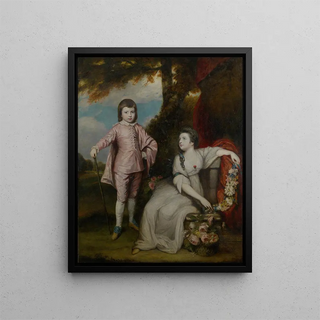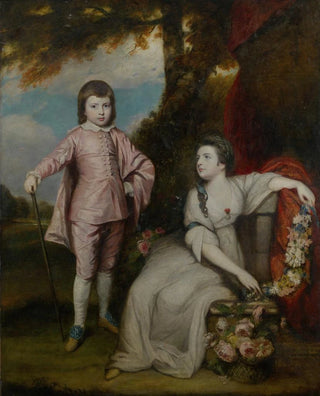Art print | George Capel, Viscount Malden (1757-1839) and Lady Elizabeth Capel (1755-1834) - Sir Joshua Reynolds


View from behind

Frame (optional)
George Capel, Viscount Malden (1757-1839) and Lady Elizabeth Capel (1755-1834) - Sir Joshua Reynolds – Captivating Introduction
The painting "George Capel, Viscount Malden and Lady Elizabeth Capel" by Sir Joshua Reynolds is much more than a simple portrait. It embodies an era when British nobility intertwined with art to immortalize their status and beauty. This artwork, both majestic and intimate, transports us to 18th-century England, a period marked by social and cultural upheavals. The penetrating gaze of the figures, the richness of the colors, and the delicacy of the details testify to Reynolds' skill in capturing the very essence of his subjects. Through this piece, viewers are invited to explore not only the faces of George and Elizabeth Capel but also the historical background surrounding them.
Style and uniqueness of the work
The piece stands out for its ability to combine realism and idealization, an emblematic characteristic of Reynolds' style. The faces of the Capels are rendered with precision that reveals their individuality while placing them within an idealized noble context. The drapery of the clothing, carefully painted, almost seems to come alive, offering texture and depth that captivate the eye. The composition is masterfully orchestrated, with the artist playing with light and shadow to emphasize the features of the figures while creating an atmosphere of serenity. The colors, both rich and nuanced, contribute to this visual harmony, reinforcing the idea of a perfect union between the two figures. This art print is not merely a portrait but a celebration of love and social status, a window into a bygone era where art served to immortalize human relationships.
The artist and his influence
Sir Joshua Reynolds, an iconic figure of British portraiture, established himself as one of the most influential artists of his time. His innovative approach and ability to capture the soul of his subjects marked a true revolution in the art world. As the first president of the Royal Academy, he also played a crucial role in promoting art in Great Britain, encouraging

Matte finish

View from behind

Frame (optional)
George Capel, Viscount Malden (1757-1839) and Lady Elizabeth Capel (1755-1834) - Sir Joshua Reynolds – Captivating Introduction
The painting "George Capel, Viscount Malden and Lady Elizabeth Capel" by Sir Joshua Reynolds is much more than a simple portrait. It embodies an era when British nobility intertwined with art to immortalize their status and beauty. This artwork, both majestic and intimate, transports us to 18th-century England, a period marked by social and cultural upheavals. The penetrating gaze of the figures, the richness of the colors, and the delicacy of the details testify to Reynolds' skill in capturing the very essence of his subjects. Through this piece, viewers are invited to explore not only the faces of George and Elizabeth Capel but also the historical background surrounding them.
Style and uniqueness of the work
The piece stands out for its ability to combine realism and idealization, an emblematic characteristic of Reynolds' style. The faces of the Capels are rendered with precision that reveals their individuality while placing them within an idealized noble context. The drapery of the clothing, carefully painted, almost seems to come alive, offering texture and depth that captivate the eye. The composition is masterfully orchestrated, with the artist playing with light and shadow to emphasize the features of the figures while creating an atmosphere of serenity. The colors, both rich and nuanced, contribute to this visual harmony, reinforcing the idea of a perfect union between the two figures. This art print is not merely a portrait but a celebration of love and social status, a window into a bygone era where art served to immortalize human relationships.
The artist and his influence
Sir Joshua Reynolds, an iconic figure of British portraiture, established himself as one of the most influential artists of his time. His innovative approach and ability to capture the soul of his subjects marked a true revolution in the art world. As the first president of the Royal Academy, he also played a crucial role in promoting art in Great Britain, encouraging






